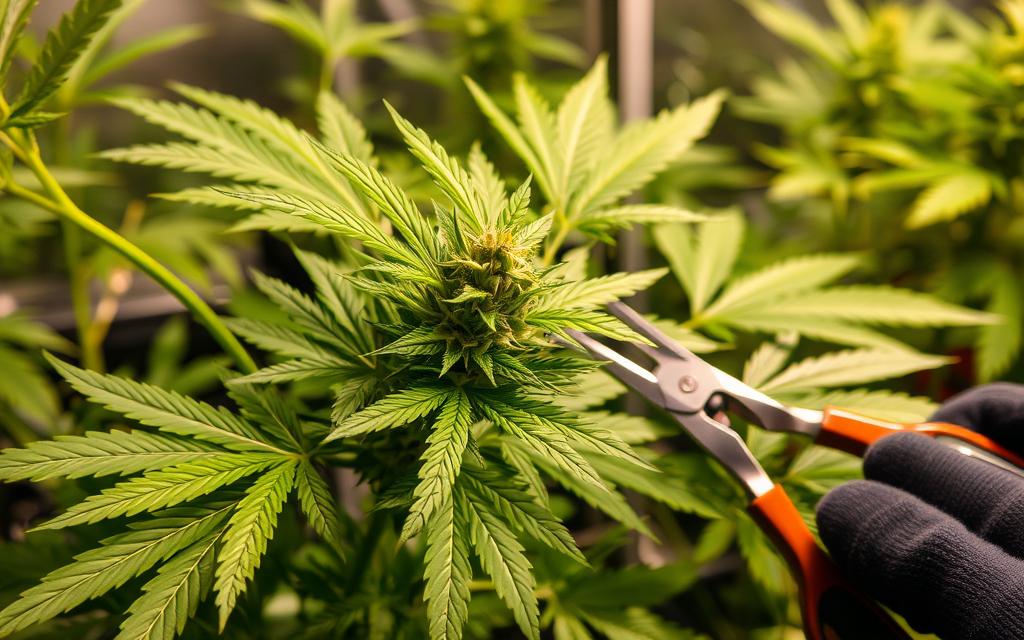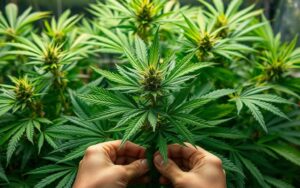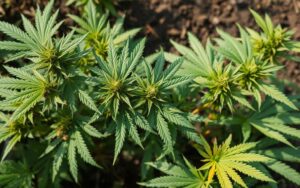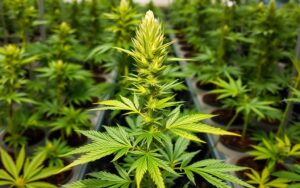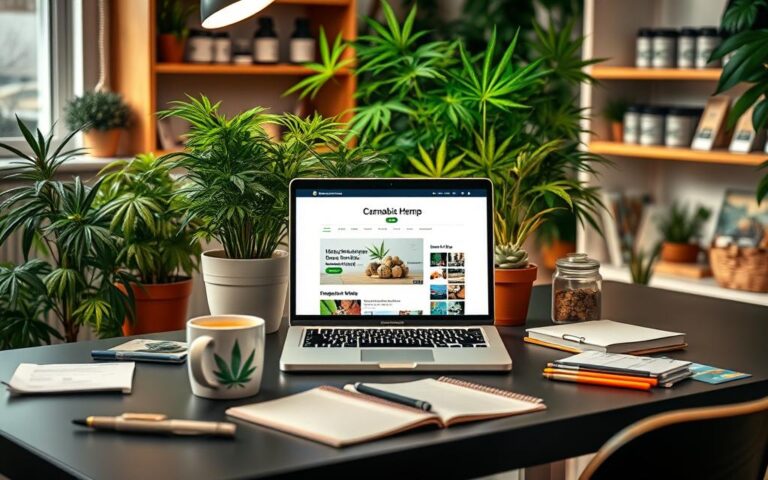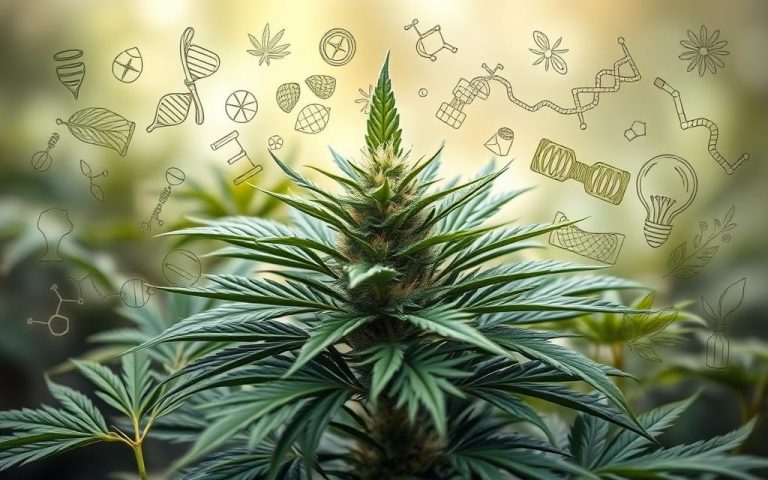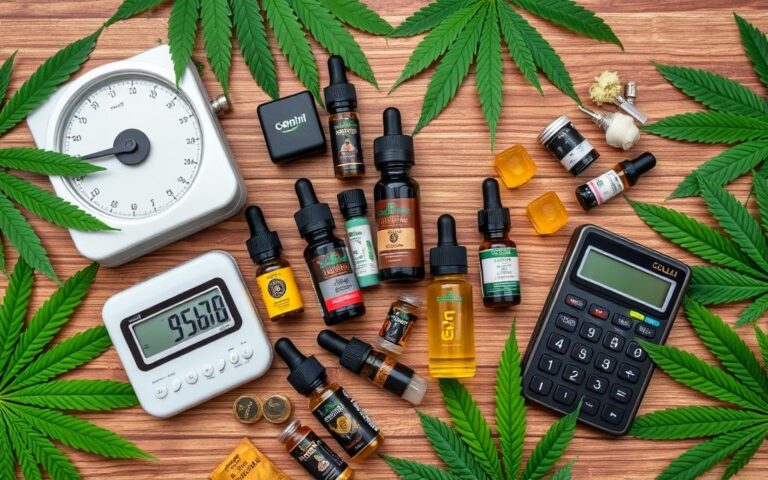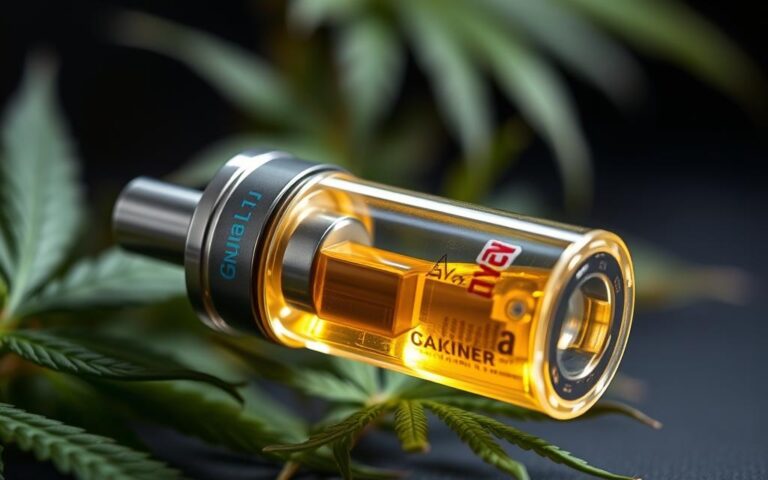How to Properly Defoliate Cannabis Plants
Defoliation is a crucial practice in cannabis plant care. It involves removing excess leaves to boost the plant’s health and yield. This technique is especially useful for those growing indoors. It helps by allowing more light and air to reach the plants. This promotes better growth.
By removing unneeded leaves, energy is redirected to the buds. This results in denser and more fruitful colas. Every grower looking to increase their yield should understand how important this process is.
Adding defoliation to your growing routine can really make a difference. But, it’s important not to remove too many leaves. That could slow down growth by affecting nutrient absorption. For detailed advice on doing it right, check out how to defoliate cannabis properly.
Understanding Cannabis Defoliation
Defoliation is key in growing cannabis. It’s vital for growers to understand cannabis defoliation definition well. By selectively removing certain leaves, plants focus more on bud development rather than excess foliage.
Defining Defoliation
The approach to defoliation varies with each cannabis strain and grow conditions. Growers use their knowledge to decide how many leaves to remove. First, they get rid of damaged or yellowing leaves. Next, they target large leaves blocking light to lower parts.
The Natural Role of Leaves
Cannabis leaves do more than just make oxygen. They store nutrients and make energy with photosynthesis. In the wild, these leaves are crucial for plant health. Yet, indoors, it’s different. Removing leaves early can prepare plants for later trimming. Doing it right during the flowering stage can increase yield and prevent pest problems.
It’s important not to remove too many leaves at once. Taking away more than 20-30% can stress the plant, slow its growth, and lower yields. Growers should watch their plants carefully after defoliation. The goal is to improve light and air flow to the plants. This results in bigger and denser buds, leading to healthier cannabis plants.
The Benefits of Defoliating Cannabis Plants
Defoliation brings big benefits for cannabis growers who want better yields and healthier plants. Understanding the benefits of defoliation helps growers use it right for their setup.
Optimising Energy Use
Removing leaves lets cannabis plants focus energy on growing buds. This can lead to a 15% better bud quality, as growers report. With over 90% of big operations using automated defoliation, it’s key for good harvests.
Improving Airflow and Light Penetration
Better cannabis plant airflow is a major plus of defoliation. It allows more light to hit the plant, creating the best growth conditions. Less leaves also means less chance for damp and mould, cutting down these problems by 25% in wet areas.
Reducing Risks of Pests and Mould
Defoliation boosts plant health and fights off pests. Better airflow and light lower the risk of bugs and diseases. With manual defoliation, liked by 60% of small growers, you get more control over your plants’ health, making them stronger.
| Aspect | Benefit |
|---|---|
| Energy Allocation | Improves bud development and increases quality by 15% |
| Airflow | Enhances cannabis plant airflow and reduces humidity |
| Pest and Mould Prevention | Reduces occurrences of mould by 25% and lowers pest risks |
| Harvest Quality | Stimulates potent and aromatic harvests through light optimisation |
Using defoliation well can really change how well your cannabis plants do. It’s a big plus for growers who follow nature’s lead with smart techniques. For more about the best times to defoliate, check out more info here.
How to Defoliate Cannabis Plants
Defoliating cannabis correctly can greatly improve plant health and yield. It’s all about timing. Knowing the best times to defoliate ensures you get the best results without harming your plants.
Determining the Right Time for Defoliation
Choosing when to defoliate is key. Some growers start heavy defoliation in the third week of flowering. Others remove leaves blocking light to buds about 11 days after changing to a 12/12 light cycle. According to Bulldognuts, removing big fan leaves can boost light penetration. This is especially true with LED lights. It also helps air flow under the canopy, cutting down mould and bud rot risks.
Step-by-Step Defoliation Process
Here’s how to defoliate cannabis plants systematically:
- Check Plant Health: Make sure your plants are healthy and well-fed.
- Get Ready to Defoliate: Keep your plants well-watered to ensure they have enough water and nutrients.
- Start with Big Fan Leaves: Remove the large leaves first to let light reach the middle of the plant.
- Trim Inner Leaves: Then, carefully remove leaves from inside the plant. Be careful not to take too many, as they’re needed for energy.
- Make Clean Cuts: Cut leaves off cleanly to avoid infection or other issues.
Avoid removing too many leaves. This can mess up the plant’s balance of energy, harming bud growth. Timing your defoliation well leads to stronger, healthier plants.
| Timing | Action | Purpose |
|---|---|---|
| Week 3 of Flowering | Heavy Defoliation | Improves light and air flow |
| Day 11 after 12/12 Switch | Remove Obstructive Fan Leaves | Helps light reach the buds |
| Throughout Growth | Assess and Remove Dying Leaves | Keeps plant healthy, focuses on important nutrients |
Growers have different approaches. Some prefer taking off fewer leaves, while others go for a more thorough clean-up. The best method depends on your own experiences and the specific conditions of your grow space.
Choosing the Right Cannabis Plants for Defoliation
Choosing the right cannabis plants for defoliation is key for success. Look for healthy plants as they show signs that they’re ready for this process. Knowing these signs improves your choice, leading to better growth and yield indoors.
Identifying Healthy Plants
Several key characteristics show if a cannabis plant is healthy:
- Strong stems: These support the foliage and buds as they grow.
- Vibrant foliage: Look for leaves that are a rich green. This shows good health and nutrient intake.
- Rapid growth: Fast-growing plants are usually excellent for defoliation.
Don’t defoliate unhealthy plants. They could get stressed, which limits their growth. Only healthy plants meeting these criteria should be defoliated for the best development.
Indoor vs Outdoor Defoliation
Where you grow your plants affects how you should defoliate them. Indoors, the controlled light and conditions make defoliation different. Here are some tips for indoor growers:
- Remove about 10-15% of foliage in the veg phase for the best outcome.
- Strong indoor plants can lose up to 20-25% of their leaves without harm.
- When flowering, it’s best to defoliate around three weeks into the stage to help buds grow bigger.
Outdoor plants get natural light that changes with the sun’s position, helping them grow better. Be cautious when choosing outdoor plants for defoliation.
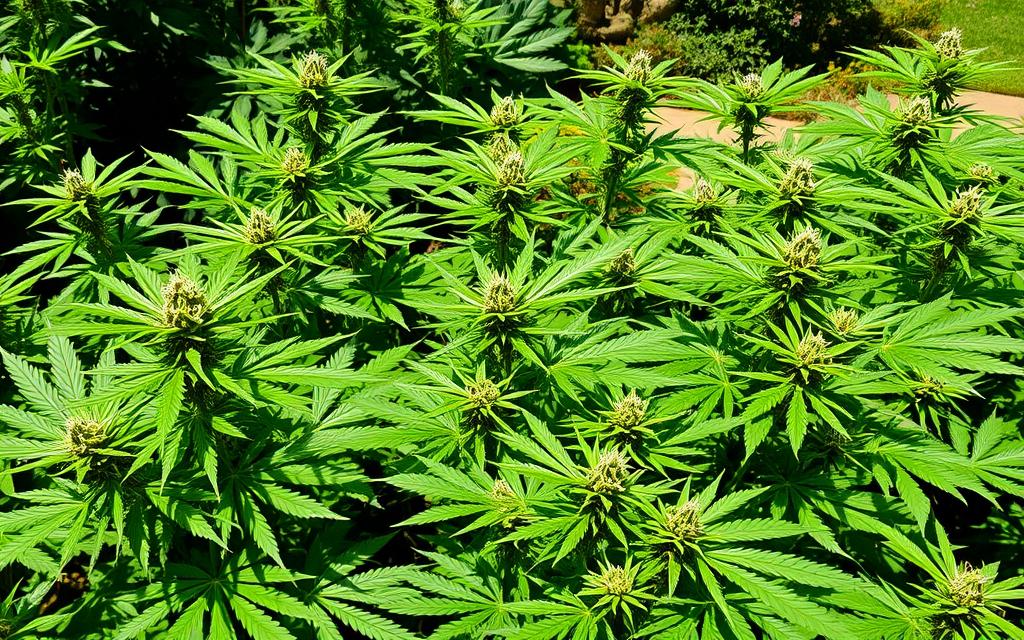
To get the best yields, pick healthy plants and know the indoor and outdoor defoliation differences. For new growers, using resources and expert defoliation advice can be very helpful. Check out this guide on cannabis defoliation for more tips.
Defoliation vs Pruning: Understanding the Differences
In the world of cannabis cultivation, defoliation vs pruning often causes confusion. While both methods remove plant parts to boost growth, they focus on different areas.
Defoliation is all about the plant’s leaves. It helps more light reach the lower parts, including the buds. Growers usually start removing leaves in the second vegetative week and stop in the second flowering week. If you’re new to this, be careful. Only remove about 10-15% of the top leaves, especially the unhealthy ones.
Pruning, however, means cutting stems and branches. It includes techniques like fimming and topping. These methods shape the cannabis but could stress or harm it, so they must be done with care.
| Aspect | Defoliation | Pruning |
|---|---|---|
| Focus | Leaves | Stems and branches |
| Timing | Begins in veg phase | Early vegetative phase |
| Primary Goal | Maximise light and airflow | Shape plant structure and manage growth |
| Typical Techniques | Removing fan leaves | Fimming, topping |
| Risks | Over-defoliation | Plant stress, potential damage |
Defoliation vs pruning – knowing the difference is key for growers. When done right, these methods can greatly improve a plant’s health and yield.
The Best Practices for Defoliating Cannabis
Defoliating cannabis plants well needs a smart plan for both growth stages. Doing it right boosts plant health and the amount of crop. Here’s what you need to know for your defoliation steps.
Strategies for Vegetative Phase Defoliation
When plants are growing, carefully taking off leaves helps light reach further and air flow better. Here’s how in the growth stage:
- Begin by removing 20-25% of leaves, focusing first on lower problem areas.
- Choose precise cutting tools like trimming scissors coated in titanium. Make sure they’re clean with top-tier isopropyl alcohol (99%).
- Watch your plants for any stress for 24-48 hours. Depending on how they react, you might adjust the leaf removal.
Tips for Flowering Phase Defoliation
In the flowering stage, be careful with defoliation to keep energy production smooth. Key tips for this phase include:
- Make sure you keep enough leaves for health while improving light to buds.
- Keep using clean tools and wear protective gear like nitrile gloves and goggles.
- Take notes on how growth and water needs change. This helps tweak your approach later on.
https://www.youtube.com/watch?v=vY6JUYyDX3w
Common Mistakes to Avoid When Defoliating
Defoliating cannabis is like an art. It needs careful attention and knowledge about what the plant requires. Making mistakes can lead to big problems, like harming the plant’s yield and health. Knowing the common errors before you start is key to doing it right.
Over-Defoliation Risks
One major mistake is taking off too many leaves. This makes the plant struggle to do important tasks like photosynthesis. It can stop the plant from growing properly and lower the amount it produces. If you’re new to growing, try to only remove leaves from the bottom half. Keep removal to less than 15% when the plant is growing.
Ignoring Plant Health
Not checking if the plant is healthy before starting can lead to big problems. Trying to defoliate a sick plant might cause damage that can’t be fixed. Plants that are well can better handle the changes. It’s very important to understand this for your plants to do well.
Here’s a table to help show what you should consider when defoliating:
| Aspect | Recommendation |
|---|---|
| First Defoliation | 1-2 weeks before flowering |
| Maximum Foliage Removal (Inexperienced Growers) | 10-15% during vegetative stage |
| Maximum Foliage Removal (Experienced Growers) | 20-25% during vegetative stage |
| Second Defoliation | 3-4 weeks after flowering onset |
| Final Defoliation (Pre-Harvest) | 1 week before harvest |
| Risks of Over-Defoliation | Reduced yields, plant stress |
| Importance of Plant Health | Helps in recovering from stress |
Conclusion
Defoliation, or removing leaves, is key for better cannabis growth and yields. It lets more light reach the plants and improves air flow. This also helps plants use nutrients better and stops mould and mildew.
Yet, defoliation needs to be done with care to avoid harm. Watching the plants and choosing the best time for leaf removal boosts harvest potential. Using the right methods can mean more flowers and better resin.
Trying different defoliation techniques, while following good advice, helps perfect this skill. With what you learn here, you can look forward to better harvests. This will improve both your growing expertise and the quality of your cannabis.

